|
|
| home > artland |
| The
Cadyville Sauna by Dan Hisel Pietro Valle |
||||
|
Watch out: at playing the ghost, you are becoming it. Roger Caillois |
||||
| [in italiano] |
Located in a forest near the Saranac River gorge in upstate New
York, the sauna designed by Dan Hisel is a little stereometric structure
that leans on a natural cliff, incorporating it within the interior.
The outer shell is completely clad in mirror panels and the path leading
to it is positioned diagonally so that no person approaching the building
is reflected. The sauna is camouflaged within the trees and the visitor
discovers it by colliding with his/her own double at the last moment
with a strong effect of displacement. Aggressed by our own reflection,
the ground becomes uncertain and the slope towards the gorge seems to
slide downwards. After this initial shock, we discover a pristine volume
that is totally impenetrable except for a window/eye that cuts diagonally
one of the corners and, because of the outer mirrors, seems to float
in mid-air. It is the only connection between the shell and the soft
interior clad in wooden boards. The sauna's temperature dissolves the
haptic surfaces of the walls and benches within a mist that seems to
originate from the occupants' sweat. |
[29dec2002] | ||
|
|
 As the outer shell disappears in the forest, the body is cancelled within the thick receptacle: the two spaces, even if different, are related. Both dissolve the boundaries between man, architecture and the environment by projecting them in total indeterminacy. With simple means, this structure succeeds in undermining the traditional distinction between figure (our body, the measuring unit of architecture) and space. The interior physical atmosphere, where vision is blinded and tactility prevails, is not able to define a clear threshold between environment and us. The phenomenological body is put on uncertain grounds and, instead of defining the measure of the world (as in Merleau Ponty's Phenomenogy of Perception), disappears into it. At the same time, the employ of mirrors on the exterior avoids any reference to the human figure (by delaying its recognition up to the last moment) and dissolves the architecture in the environment disrupting the traditional separation of figure and ground. |
|||
 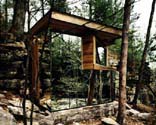 |
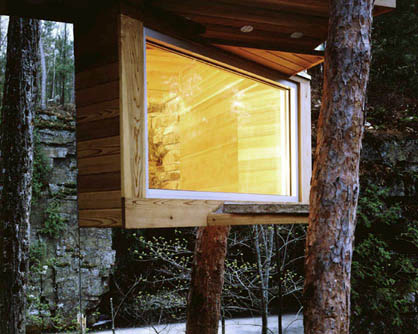 The building is denied an identity, a stable material presence, a comprehensive form and an architectural language. It refuses a distinct image but is not even able to borrow one from its surroundings (as in urban mirror facades) because it is totally undistinguished from the trees, rocks and leaves that multiply on its surfaces. This mimetic condition is interesting: the mirror is not double (as in Lacan's psychoanalysis), is not projective (as in the perspectival tradition), is not displacement (as in Foucault Heterotopias) but only self-annulment. The figure becomes the space but the space swallows it, it is a black hole where any representation or reference implodes. |
 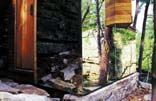 |
||
| NOTE: (1). Roger Caillois, "Mimicry and Legendary Psychastenia", translated in English in October 31, 1984, pp. 59-74. The text by Dan Hisel on the aforementioned website is "Dysappearances: An Essay on Camouflage, Darkness and Architecture", 2001. |
Writing about the sauna in his website,
Hisel quotes an extraordinary text by Roger Caillois published on the
surrealist magazine Minotaure in 1938, "Mimicry and Legendary
Psychastenia". (1) In it, the French writer/philosopher analyses the
behaviour of insects that camouflage within the environment, linking
them to schizophrenic forms of loss of identity. Talking about schizophrenics,
Caillois writes: "...their inevitable response to the question: where
are you? is I know where I am but I do not feel as though I am
at the spot where I find myself. To these dispossessed souls, space
seems to be a devouring force. Space pursues them, encircles them, digests
them in a gigantic phagocytosis. It ends by replacing them. Then the
body separates itself from thought, the individual breaks the boundary
of his skin and occupies the other side of his senses. He tries to look
at himself from any point whatever in space. He feels himself
becoming space, dark space where things cannot be put. He is
similar, not similar to something, but just similar. And he invents
space of which he is ‘the convulsive possession'. All these expressions
shed light on a single process: depersonalisation by assimilation
to space... The feeling of personality, considered as the organism's
feeling of distinction from its surrounding, of the connection between
consciousness and a particular point in space, cannot fail under these
conditions to be seriously undermined". The pathological situation described
by Caillois is reiterated in the Cadyville Sauna, a building without
a body and that avoids a defined relation with inhabitants and place. |
   |
||
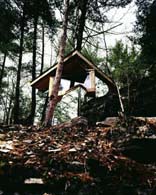 |
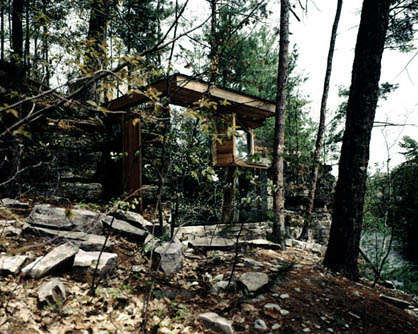 Experiments in spatial estrangement as the one attempted by Hisel are not simply a gratuitous exercise of de-territorialization but relate to many critical practices within contemporary art and architecture that try to dissolve and extend the boundaries between surfaces, form, materials and the environment. From Robert Smithson's Displacements to Dan Graham's Two-Way Mirror Pavilions, from James Turrell's Light Environments to Diller+Scofidio's Blur Building, there is a research that does not link impermanence in architecture only to formal languages but explores the multiple links among (apparently simple) spaces, materials and body by taking them to a gradual dissolution. By doing this, they comment on the lack of reference points within Post-Modern culture but also open up to other possible relationships, maybe more critical, possibly not linked to hierarchies inherited from the past. The Cadyville Sauna too, while it comforts our body within nature, contributes to the deconstruction of the primitive hut that was thought to be the basic mediator between man and the environment. The archetype is gone: what remains is a critical research, still to be concluded, on the possible relations that architecture can establish with an unstable world, case by case. Pietro Valle |
|||
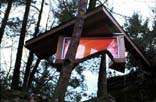 |
The Cadyville Sauna was designed by Dan Hisel, built by Hisel himself with the help of Tom Gerner. The photographs are by Don Dimster and Jennifer Roberts, courtesy of Dan Hisel. | |||
| > DAN HISEL | ||||